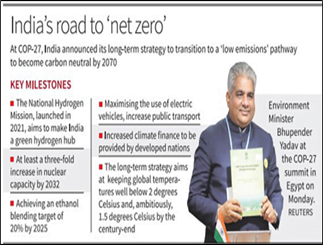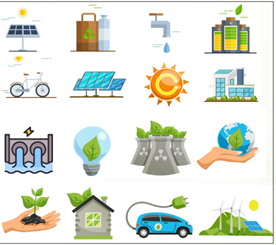Environment & Ecology
Context: Recently India submitted its Long-Term Low Emission Development Strategy to the United Nations Framework Convention on Climate Change (UNFCCC) at the 27th Conference of Parties (COP27) which was held in Sharm-el-Sheikh, Egypt.


About 27th Conference of Parties (CoP27):
- Conference of Parties(COP) is the supreme decision-making body of the UNFCCC.
- The agreement seeks to limit global warming to well below 2°C, preferably to 1.5°C, compared to pre-industry levels.
- COP27 was labelled as an “implementation” conference, in the sense that countries were determined to solve outstanding questions on climate finance.
- This refers to money that developed countries had committed to developing countries to help them turn their economies away from fossil fuels, build resilient infrastructure to climate shocks and access technologies to enable widespread use of renewable energy.
About Long-Term Low Emissions Development Strategy:
- The 2015 Paris Agreement requires all parties to create a long-term low greenhouse gas emissions development strategies (LT-LEDS) based on their various responsibilities and capabilities as per the different national-level circumstances.
- The COP26, held in Glasgow in November 2021, required the parties who have not yet communicated their LT-LEDS to submit them by COP27.
- India’s LT-LEDS was prepared after extensive consultations with various government entities, state governments, research institutes and civil society organizations.
Key Pillars of the India’s strategy: The 7 key pillars of the strategy are
- Low-carbon electricity systems consistent with development
- Integrated, efficient and inclusive low-carbon transport systems,
- Energy and material-efficiency in buildings,
- Decoupling growth from emissions and developing an efficient, low-emission industrial system,
- CO2 removal and related engineering solutions,
- Enhancing forest cover consistent with socioeconomic and ecological considerations
- Increasing climate resilience in poverty eradication and employment creation.
Salient features of India’s (LT-LEDS):
- Forest Cover: India has a strong record of enhancing forest and tree cover in the last three decades alongside high economic growth.
- India’s forest fire incidence is well below global levels, while its forest and tree cover are a net sink absorbing 15% of CO2 emissions in 2016.
- India is on track to fulfilling its NDC commitment of 2.5 to 3 billion tonnes of additional carbon sequestration in forest and tree cover by 2030.
- Transition from fossil fuels: The transition from fossil fuels will be undertaken in a just, smooth, sustainable and all-inclusive manner.
- Transportation sector: Increased use of biofuels, especially ethanol blending in petrol, the drive to increase electric vehicle penetration and the increased use of green hydrogen fuel is expected to drive the low carbon development of the transport sector.
- Sustainable Urbanization: Future sustainable and climate-resilient urban development will be driven by smart city initiatives, integrated planning of cities, effective green building codes and rapid developments in innovative solid and liquid waste management.
- Industrial Sector: India’s industrial sector will continue on a strong growth path in the perspective of ‘Atma Nirbhar Bharat’ and ‘Make in India’.
- The focus will be on improving energy efficiency by initiatives such as Perform, Achieve and Trade (PAT) scheme, high levels of electrification, enhancing material efficiency and recycling leading to the expansion of the circular economy.
- Transition to low-carbon development: The transition to the low carbon development pathway will entail several costs pertaining to the development of new technologies, new infrastructure, and other transaction costs.
- The provision of climate finance by developed countries will play a very significant role in this.
India’s NDCs:
- The NDCs, which India must periodically update, are voluntary commitments by countries to reduce emissions by a fixed number relative to a date in the past to achieve the long-term goal of climate agreements of preventing global temperature rising beyond 1.5°C or 2°C by the end of the century.
- Thus, India’s most updated NDC commits to ensuring that half its electricity is derived from non-fossil fuel sources by 2030 and reducing the emissions intensity by 45% below 2005 levels by 2030.
- They are concrete targets unlike the low-carbon strategy which is qualitative and describes a pathway.
Issues associated with climate resilient strategies:
- Funding: Of nearly $100 billion annually committed in 2009, which was to have been arranged for by 2020, less than a third has come in.
- Much of this, and this has been pointed out by several countries including India, is in the form of loans or come with conditions that increase the economic burden on developing countries.
- Clear delivery: There is a demand that developed countries must come up with a new target, described in negotiations as a New Collective Quantified Goal, with a clear path of delivery and a higher amount, to the tune of “trillions of dollars” to account for increased costs of energy transition.
- Loss and Damage: This is a proposal to compensate the most vulnerable countries and developing countries who are facing the brunt of climate change for the damage that has already incurred.
- The European Union was resistant to announcing a fund this year, on the grounds that it would take years to materialise and there were other options to get money flowing where it was most needed.
- Action plans falling short: It’s been at least two-and-a-half decades since the world decided to restrain its greenhouse gas emissions.
- Latest assessments suggest that current action plans of countries to meet climate goals are falling woefully short.
- Rising emissions: In absolute terms, the annual global emissions are still rising, now touching almost 50 billion tonnes of carbon dioxide equivalent.
- In the decade between 2010 and 2019, the global emissions grew by over one percent on average.
- This is significantly slower than the growth in the previous decade, of about 2.6 percent, but for meeting climate targets, it is not good enough.
- Ukraine war: The energy and economic crisis caused by the Ukraine war is threatening to undo even the small gains made.
- Inadequate & unfair response: The response in terms of emission cuts has been inadequate.
- The rich and industrialised countries:
- These were the main polluters and hence mainly responsible to bring down emissions, have not met their collective targets.
- Developing countries: Countries like China or India, which were not major emitters till sometime back, have seen their emissions rise steeply.
Global picture
- EU: As a bloc, the European Union has done relatively better on climate goals, with the United Kingdom, which is struggling with an economic downturn right now, halving its emissions from 1990 levels, UN data shows.
- USA: The United States, the world’s leading emitter until it was overtaken by China in the mid-2000s, has been a major laggard, cutting its emissions by only about 7 percent from 1990 levels.
- India & China: China’s emissions have risen by almost four times, and India’s by about three times, during this period.
Way Forward:
- Climate change is a global problem and it requires cooperation between all nations along with adopting rules that are fair and just, for the poor and the rich alike.
- Science is clear that humans are responsible for the global temperature rise and that this increase will lead to more and more variable and extreme weather events, much like what we are seeing now.
- it is possible to estimate each country’s responsibility for the stock of emissions already in the atmosphere — the historical cumulative emissions that have “forced” climate change impacts.
- Countries that have not yet contributed to the emissions will do so in the future, simply because the world has reneged on the need to make global rules that would apply fairly to all.
For a realistic chance to keep global warming within 1.5 degree Celsius, annual emissions would need to drop from the current level of about 50 billion tonnes of CO2 equivalent to about 33 billion tonnes by 2030 and 8 billion tonnes by 2050, according to the newest Emissions Gap Report. Even for meet the 2-degree target, emissions have to come down to about 41 billion tonnes by 2030 and 20 billion tonnes by 2050.This would require drastic action from all the major emitters.
Source: PIB
Previous Year Question
Q.1) In the context of India’s preparation for Climate-smart Agriculture, consider the following statements:
- The ‘Climate-Smart village’ approach in India is a part of a project led by climate change, Agriculture and food security (CCAFS), an international research programme.
- The project of CCAFS is carried out under Consultative Group on International Agricultural Research (CGIAR) headquartered in France.
- The International Crops Research Institute for the Semi-Arid Tropics (ICRISAT) in India is one of the CGIAR’S research centres.
Which of the statements given above are correct? (2021)
- 1 and 2 only
- 2 and 3 only
- 1 and 3 only
- 1,2 and 3














